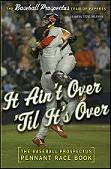There was an interesting piece in The New York Times on September 19th by Alan Schwarz titled "Ball Four! Take Your Measly Base, Slugger". Schwarz is the author of The Numbers Game. In the piece Schwarz discusses the 1.433 OPS of Barry Bonds (at the time of the article - Barry has since broken his own 2002 record for OPS with 1.422) and how David Neft, the former vice president for research at Gannett, devised OAPS (On-base advantage plus slugging percentage) in order to "acknowledge this strategic aspect of the game: how walks are, to varying degrees, conscious choices by pitchers to avoid the potential damage done by slugging."
To take this into account Neft subtracts the batter's slugging percentage from 1 and uses this in the calculation of what he calls "on base advantage". Basically, this is an acknowledgment that there is an opportunity cost associated with taking a walk and that pitchers sometimes choose to walk a batter based on the potential damage pitching to the batter could do. So in practice this means that if a batter had 240 total bases, 80 walks, and 150 hits in 500 at bats his OBA would be .397, his SLUG .480, and his OPS .876. His OA would then be .330 since his walks would be worth only 52% of normal (1-.48) and his OAPS .810.
For a slugger like Bonds the difference between his OBA and OA will grow proportionately with his walk total. Whereas in our average player the difference was only .024, for Bonds it's more like .35 - fifteen times the difference and has the effect of bringing his OAPS down to around 1.07 or so. The following chart illustrates how OPS continues to rise more sharply as a batter accumulates walks while OAPS has a much smaller slope, rewarding batters less for each walk.

This approach also seems to hold up fairly well in computer models as noted by Schwarz:
"Mark Pankin, a 59-year-old investment adviser and avid baseball statistics researcher in Arlington, Va., plugged Neft's concept into his computer model and found it held up. Though the average walk costs a pitcher 0.33 runs, Bonds's walks each cost 0.17, with other players' figures going up as their slugging percentage goes down: Beltre (0.25), Guerrero (0.27) , up to the notoriously nonslugging David Eckstein of the Angels (0.36). 'It can be a meaningful difference: about 40 percent from Beltre to Eckstein,' Pankin said."
What Pankin is saying is that when Bonds doesn't walk, his plate appearances are worth an average of .16 runs. As a result, when a pitcher walks him it increases the run potential .17 runs (.33 - .16). For Eckstein on the other hand his runs per plate appearance are -.03 and so when a pitcher walks him it increases the run potential by .36 runs (.33-(-.03)). In other words it is relatively less costly to walk Bonds than it is to walk Eckstein. And of course whether you want to roll the dice and see if Bonds will make an out depends in large part whether there are runners on base, hence the strategic nature of many of his walks.
However, there is something that doesn't quite sit right about this. I don't really like the idea of punishing a hitter because they have a high slugging percentage.
One way to correct this would be to only weight Bonds' intentional walks using the formula suggested by Neft. After all, it is in these situations when we know that the defense chose a strategy of avoidance. Since 120 of Bonds 232 walks were intentional, they should be counted at .188 giving Bonds effectively 135 walks (.188*120+112) or valuing each walk at .58. Guerrero on the other hand had 14 IBB and 38 regular walks and so his walks would be valued at .84 (((14*.401)+38)/52).
But of course making this correction doesn't acknowledge the times a hitter is pitched around resulting in a "regular" walk. And for those hitters who never get an intentional walk their walks will always be valued the same as a base hit in the OPS calculation, something we know from Batting Runs that is not correct. Walks are 70% as valuable as singles overall, being worth .33 runs with singles at .47. A better approach overall would simply be to use Batting Runs with a weight such as .17 or so for the intentional walks.
In the end of course, one of the main strengths of OPS is that it is good for back of the envelope calculations and so introducing more complexity into it defeats some of its purpose.
Tuesday, October 19, 2004
OPS vs OAPS
Posted by
Dan Agonistes
at
9:50 AM
![]()
Subscribe to:
Post Comments (Atom)
125x125_10off+copy.jpg)



No comments:
Post a Comment